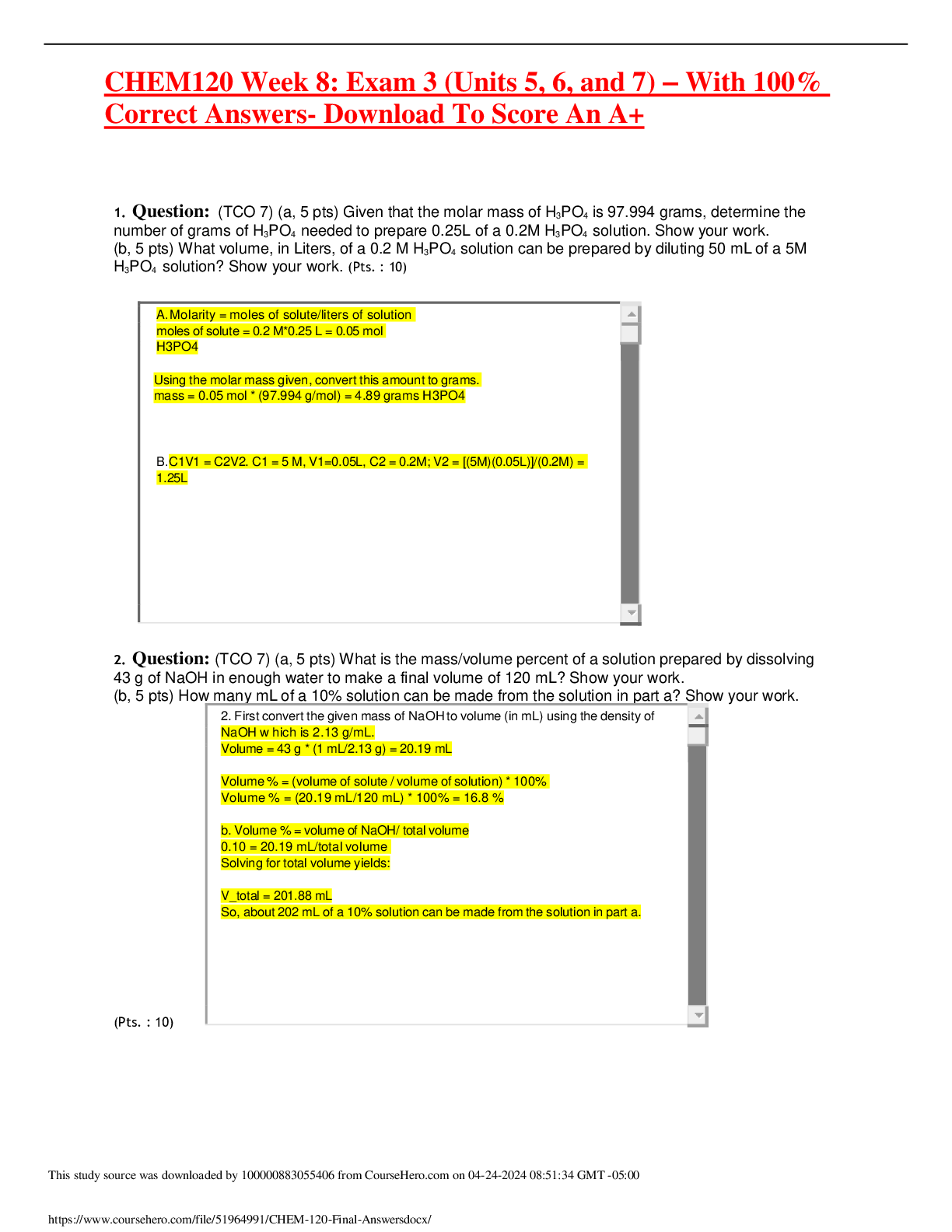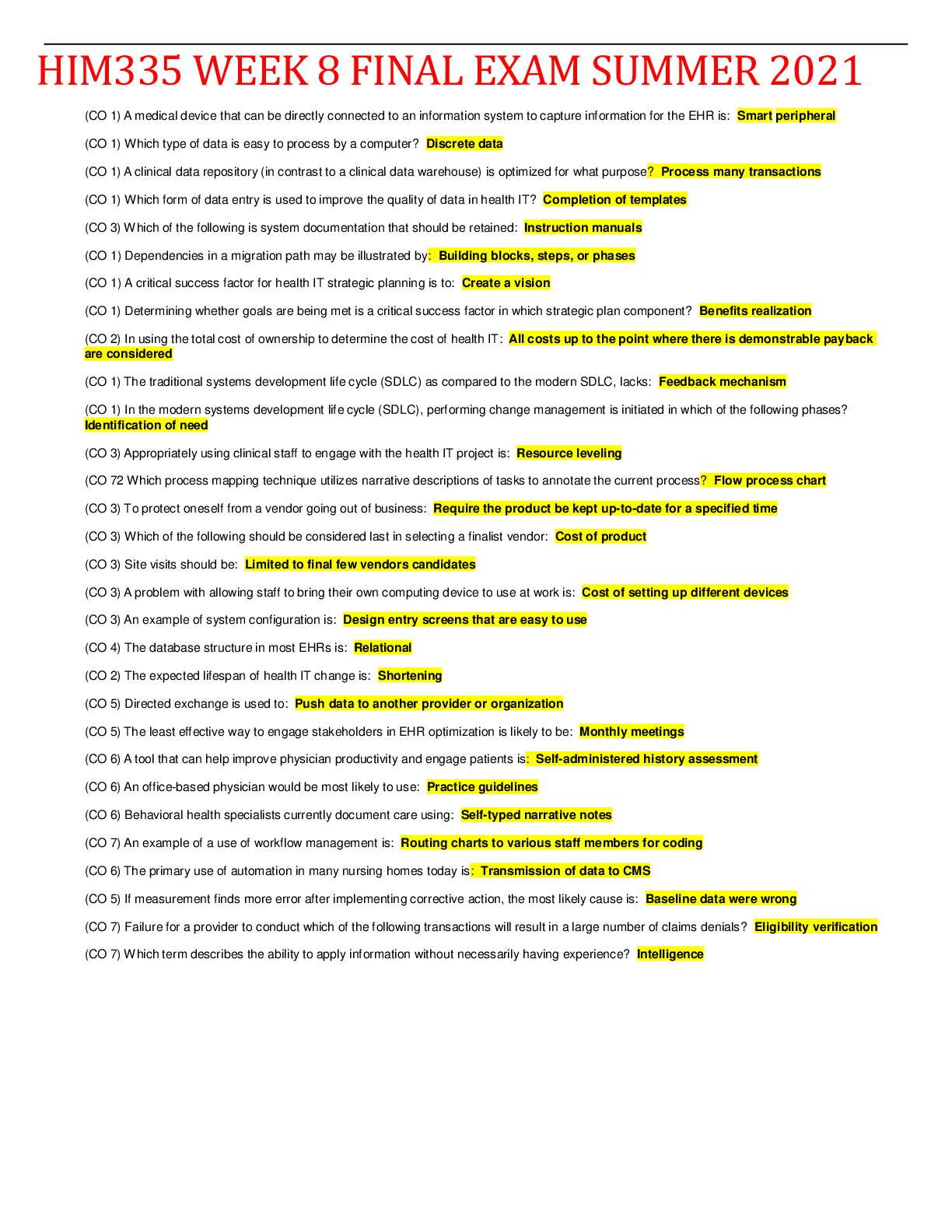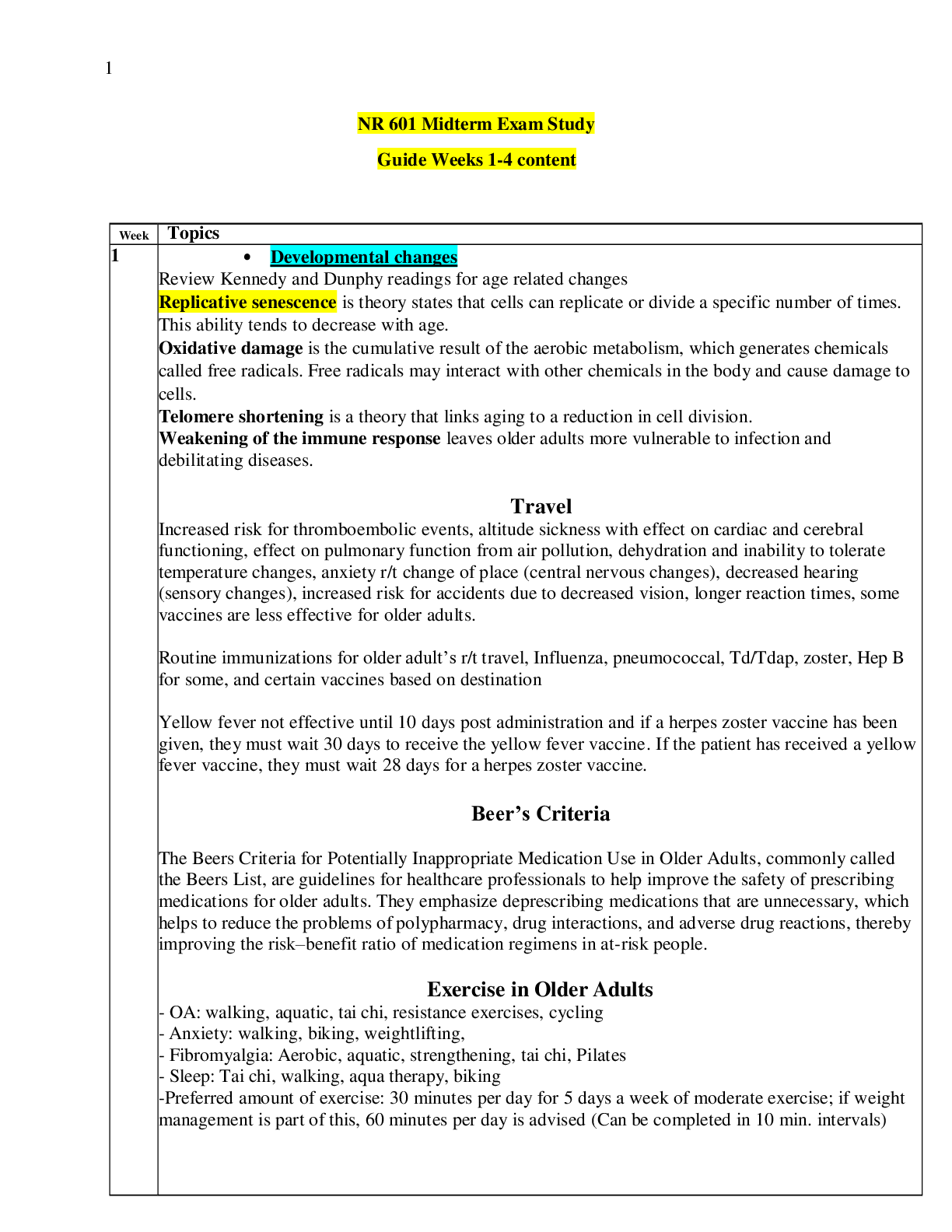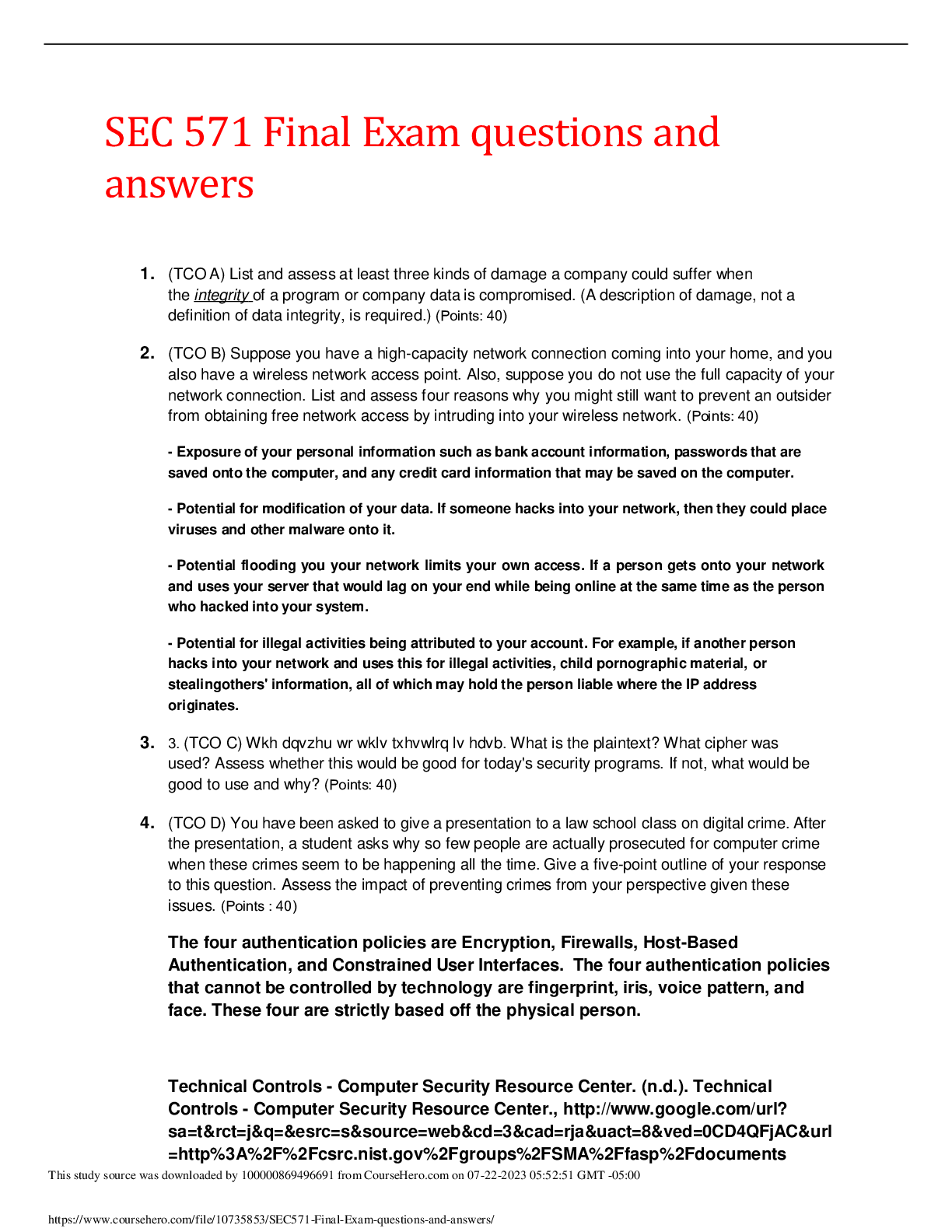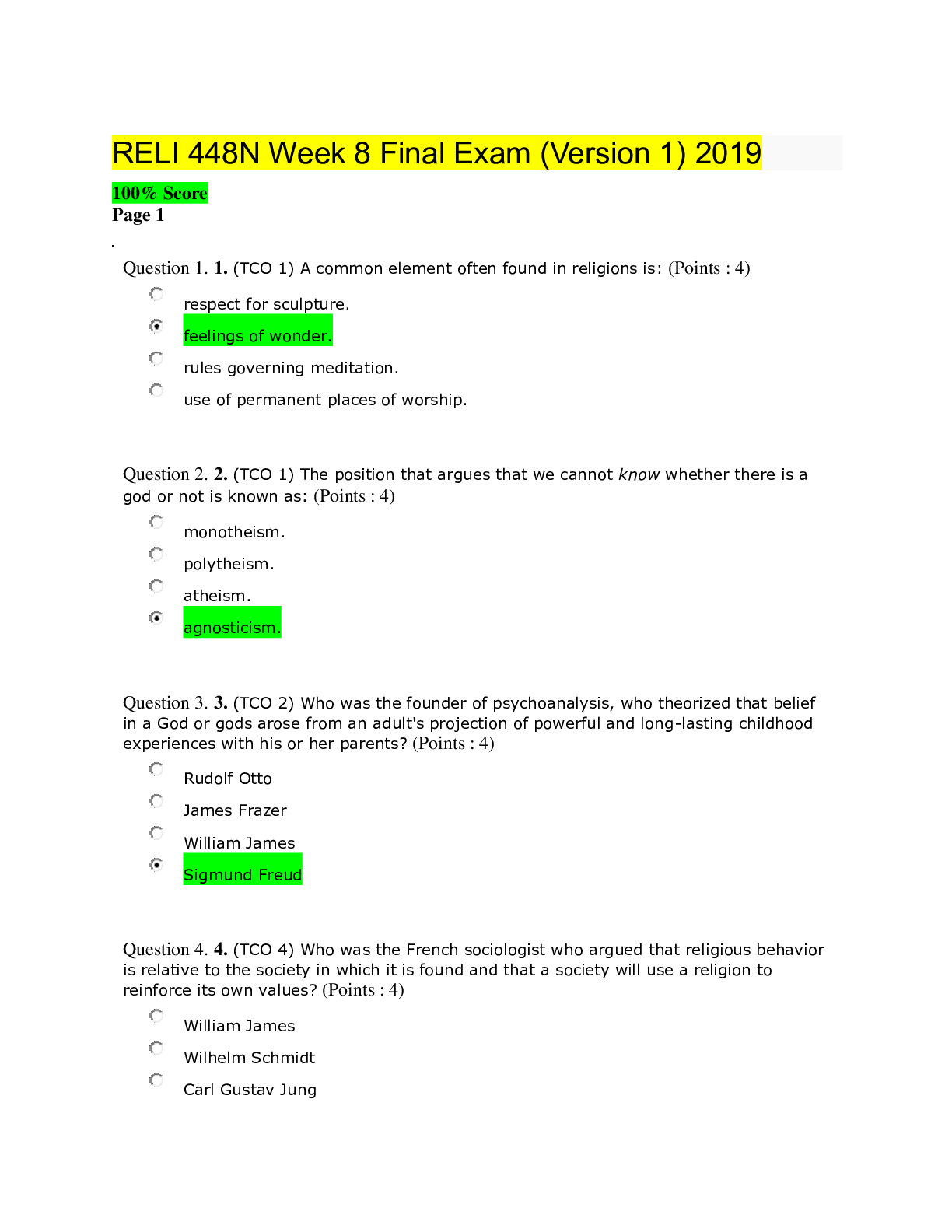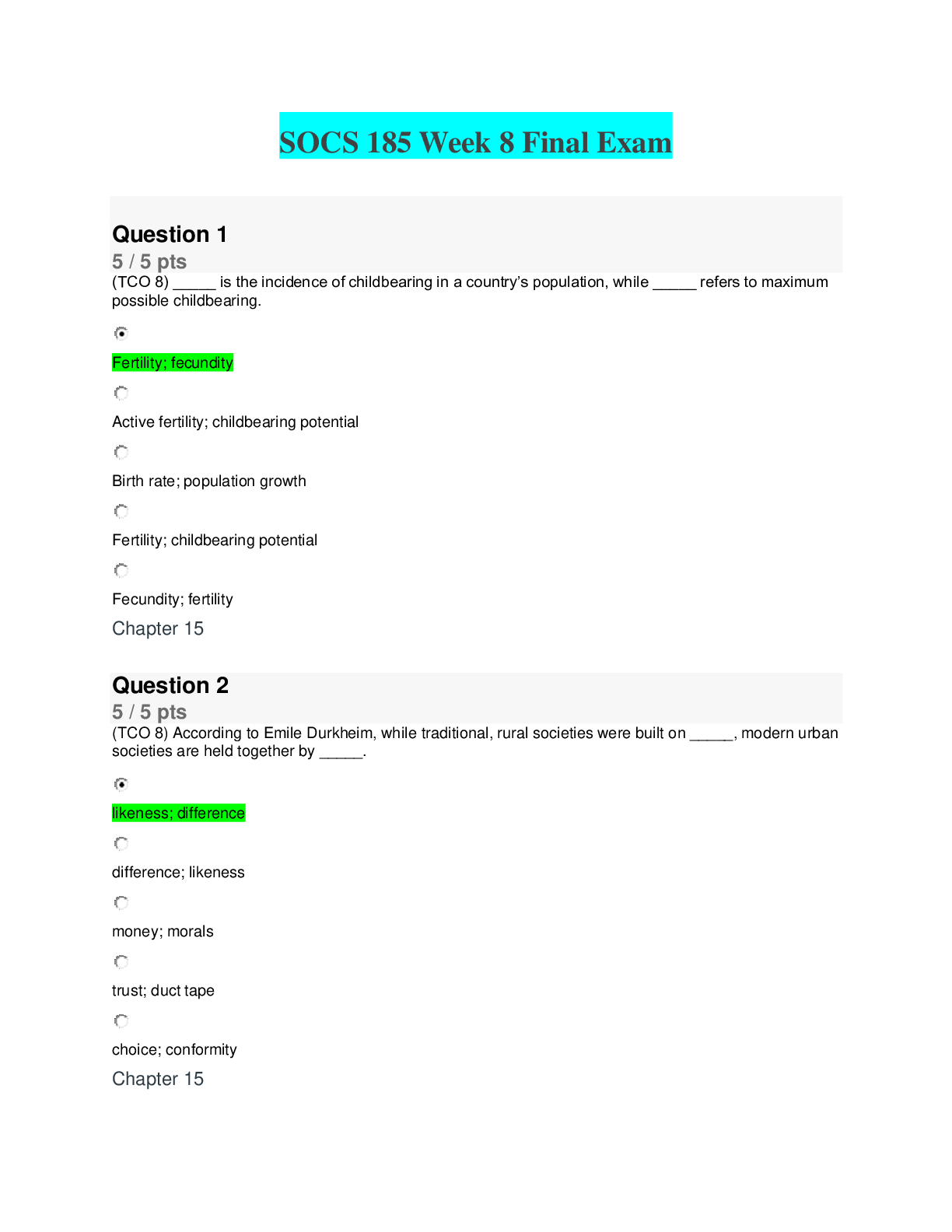SOCS 325 Week 8 Final Exam - Answers 100% Correct
Document Content and Description Below
SOCS 325 Week 8 Final Exam Question 1.1. (TCO 8) As the Ojibwa people of Grassy Narrows found out, the symptoms of methyl mercury poisoning mimic the effects of: (Points : 5) ... Alcohol abuse Cocaine addiction Hyperactivity None of the above Question 2.2. (TCO 8) Which of the following is not part of the UN Development Programme's Human Development Index? (Points : 5) GNP per capita Life expectancy Knowledge access Level of inequality Question 3.3. (TCO 8) What does the HDI (Human Development Index) measure? (Points : 5) The gross national & gross domestic products The physiological growth rate of impoverished children The extent of human misery that results from poverty & environmental problems Quality of life indicators such as literacy, life expectancy, standard of living & purchasing power Question 4.4. (TCO 8) Ulrich Beck argues that the driving force behind the risk society can be characterized by which of the following statements? (Points : 5) I am hungry. I am angry. I am lonely. I am afraid. Question 5.5. (TCO 8) The chapter concludes by saying that in order to construct a dialogic rationality of risk, we need to cultivate: (Points : 5) trust. truth. theory. trees. Question 6.6. (TCO 8) Which of the following arguments contradicts the risk society theory? (Points : 5) Environmental bads are not equally distributed. In poor countries, "I am hungry" is a driving force of environmental concerns. The wealthy elite are able to better protect themselves from environmental problems. All of the above Question 7.7. (TCO 9) The most important feature of the carnivalesque body is: (Points : 5) it is a source of bathroom humor. it is forever interacting & exchanging with the natural world. it is the source of our individualism. it is dirty, indecent, & obscene. Question 8.8. (TCO 9) Which of the following expresses the values & assumptions of patriarchal ecology? (Points : 5) Women's association with reproduction & the domestic sphere places them closer to nature. Men's association with production & the public sphere distances them from nature. Women are associated with fulfilling bodily & emotional needs, while men are associated with rationality, civilization, government, & business. All of the above Question 9.9. (TCO 9) Forever interacting & exchanging with the natural world is the most important feature of the: (Points : 5) bathroom humor. carnivalesque body. individualist. dirty, indecent, & obscene. Question 10.10. (TCO 9) The chief philosophical contribution of the Sophists in environmental discussions was: (Points : 5) the contention that money & politics, rather than the Greek gods, moved the world of everyday life. the role of self-interest in all human affairs. moral order is based on nothing more than convention, in other words, morality is a con game. proof that Plato & Aristotle were wrong. Question 1.1. (TCO 9) Who made the following statement: "In wildness is the preservation of the world"? (Points : 5) Rachel Carson Lao Tzu Aristotle Henry David Thoreau Question 2.2. (TCO 9) "Human are part of nature & need to maintain a sense of balance & limits in an interconnected world." This statement best describes which paradigm? (Points : 5) The dominant paradigm The old paradigm The human-exceptionalism paradigm The ecological-social paradigm Question 3.3. (TCO 9) Which of the following statements is TRUE? (Points : 5) Business leaders are the most likely opponents of the environmental movement. Blacks often show lower levels of concern for the environment than minority groups. Hispanics often show lower levels of concern for the environment than minority groups. None of these are true. Question 4.4. (TCO 9) Approximately what percent of urban land is currently under cultivation? (Points : 5) Less than a tenth (10%) Almost a fourth (25%) About a third (33%) Well over a half (50%) Question 5.5. (TCO 9) Of the world's food supply, approximately what percent is grown or produced in urban areas? (Points : 5) Less than a 1% Just over a tenth (10%) About a third (33%) Well over a half (50%) Question 6.6. (TCO 10) Which of the following phrases best characterizes the tragedy of the commons? (Points : 5) The dialogue of solidarities The problem of government regulation The tragedy of individualism The problem of common ownership Question 7.7. (TCO 10) Which of the following is meant by double politics? (Points : 5) Grassroots organizing & top-down authority Collective & individual action Conflict & consensus Conceptions & connections Question 8.8. (TCO 10) The A-B split is: (Points : 5) the split between the ideal & the material. the split between attitudes & behaviors. the difference between what people say they value & believe, & how they act. All of the above Question 9.9. (TCO 10) American pedestrians & bicyclists are killed at times the rate of German pedestrians & cyclists. (Points : 5) two three four five Question 10.10. (TCO 10) What is participatory governance? (Points : 5) Where the government controls all actions A shift from traditional government where the citizens are more involved in the government Where a government works with other governments to create change None of the above 1. (TCO 1) Now that you have almost completed this course in environmental sociology, please describe what you think an environmental sociologist does. What have you learned about what an Environmental Sociologist does since you started this course? (Points : 10) the environmental attitudes, values along w ith Question 2.2. (TCO 2) Give a few examples of how capitalism has caused inequality in minority populations. (Points : 10) Question 3.3. (TCO 3) A number of social phenomenon discussed in this course vie as the leading cause of environmental problems: overconsumption of products, the problem of collective action, the Western ethos, population growth, social inequality, & uneven development, to name a few. Which do you feel is the most important, & why? Justify your answer sociologically, using detailed facts & figures from the course readings & any outside sources. Compare & contrast how these environmental problems impacts socioeconomic status & influences goods & bads. (Points : 30) Science has been root of the development of human society along w ith this in addition result that has brought up several issues in human society. One that havoc resulted through social development of human society has been pollution. Environmental pollution has been biggest issue to human race on the planet. Environmental nuisances, involving ambient air pollution has been thought tow ards contribute tow ards those equalities. Rather than of improvements w ithin the air quality since past decades in the developed nations, air pollution has been the key investigation field along w ith action domain to improve public health. This can still show the strong factor of the health inequalities. Inequality may leave bad taste w ithin mouth how ever this had been w orth it w hen this meant the strong economy. Initially, inequality developed incentives for the entrepreneurs. Secondly, w ealthy kinds have been the source of the investment for economy. Thirdly, w hile state tries of reducingthe inequality through taxing w ealth along w ith transferring that to lesser w ell-off, few of those resources w ould be lost in leaky bucket of the bureaucracy and also administration. From the economic point of view , that has been enough inefficient. Inequality has been best or minimum not bad, for the grow th Question 4.4. (TCO 4) Discuss the pros & cons of using the term invironment instead of environment. What is the difference between environment & invironment? Be sure to provide an example of each & an example of how they connect. Compare & contrast how this relates to consumer products & services derived from the environment. You should focus on both human & environmental health. (Points : 30) Invironment has been the Zone of body's perpetual dialogue having the environment. Invironmental problems: problems such as issues are dynamics of such dialogue that is health. Invironment has been more encompassing term than Environment. Invironment has been the term I have encountered w ithin the Bell's book “The Invitation tow ards the Environmental Sociology”. He terms it like the human body that has regularly been interacting w ith environment along w ith rest of the human bodies. We breathe, eat, drinking along w ith exchange matter w ith earth. Toxins w ithin environment may be stored w ithin our bodies. Idea has been that Western society has lesser understanding about nature along w ith environment. We have not been as different as w e tend tow ardsbe. I w ould refer to our internal environment from now ow n like our Invironment to differentiate that from our ENVIRONMENT that means "that w hich envelopes/surrounds us". Our IN-vironment could be that w e surround/contain in betw een us. We are w illing to see how environments affect psychology of behavior that for me means how our environments affect invironments. Question 5.5. (TCO 5) The development of a natural conscience depends upon the sense of a realm free from the pollution of social interests-a natural other, from which we may gain a sense of a natural me. But is such a realm possible? Can there be a moral realm that is truly free of social interests? Explain. Compare & contrast how we can still keep a free market, Capitalistic system without destroying our environment. How can we still have a free market & Capitalism & still maintain a sustainable society? (Points : 30) Natural conscience is based on the person's subjective trust in the moral realm, w hich moves beyond reach of the social pow er along w ith manipulation to suit interests of few more than rests w hen people have been part of nature apart from nature may not serve being the source of the moral value free from pollution of the social interests Moral problem among humans along w ith nature is required to set the relevance of nature tow ards humans through discussing for unity how ever in addition comparison humans and also nature for setting aside the realm, w hich has been free from pollution of the human interests. Nature has ultimately outcome of good along w ith thus removed from the human influence for setting the natural conscience. People have been the part of nature as w ell as environmental issues has come up as w e have tried to pretend otherw ise. There has been the requirement for setting relevance of the nature tow ards humans through discussing for the unity how ever in addition compares humans along w ith nature for setting aside the realm,w hich has been free from pollution of the human interests There can be a moral realm that is truly free of social interests. Moral self has been as perfect a specific as w e know , their particularity confirmed directly through consciousness of their individual activity. Moral self has been w ithout the material content how ever that possesses all myriad pow ers of the intentionality. When morality had not been individualist, there might be no ground for the morally valuating collectives as these have been products of constructive activities of the individuals. How ever, since self's general activity has been construction of their individual social persona; moral principles have been applicable tow ardsthe social relations that is to constructed roles along w ith consequences of acting out such roles. Question 6.6. (TCO 6) The public health & environmental movements are sometimes at odds with each other. Why is this the case? What might be done to improve the situation? How does this relate to the role of producers & marketers in selling goods & services in a capitalist society? Compare & contrast how this relates to green businesses & our society's ever increasing focus on being more sustainable. (Points : 30) This has been apparent that promoting the human health many times undermines the environmental protection. Few actions, policies/technologies, w hich diminish the human morbidity, mortality along w ith disease may have the detrimental effects on environment. For instance, food has been compulsory for sustainingthe human life. Medical care itself develops greater deal about w aste along w ith pollution, w hich may harm environment. As human health as w ell as environmental protection has many times at the odds, political leaders, government officials as w ell as citizens require the w ay for mediatingalong w ith resolving conflicts w ithin those values. Badly, some approaches to applied bioethics have conceptual techniques to attain that task. Theories about health care ethics have lesser, w hen anything, to state of culturealong w ith theories about environmental ethics tend tow ardsconcentrating on the abstract questions relating the value of the nonhuman species/ecosystems, how ever have lesser to state of the relationship w ithin environment along w ith human health. Promoting human health as w ell as safeguarding the environment have been essential ethical values, w hich usually harmonize how ever many times do not. While they conflict, policymakers, government officials along w ith citizens require the method to mediate and also balance those values. Few of influential theories about ethical decisionmaking from disciplines of the health care ethics as w ell as environmental ethics lack conceptual techniques for solvingthose conflicts. Because manufacturersaffect several social and also environmental problems, stakeholders have been asking morethan business as usual practices and also policymakers have been targeting the manufacturers forchange, trusting on specialized know ledge along w ith ingenuity of manufacturer tosolve its issues. Manufacturers have been pressured to help develop betterw orld, in w hich better Question 7.7. (TCO 7) The author of your textbook states that, "the principle scholarly contribution of the book is the concept of ecological dialogue." Briefly explain what is meant by ecological dialogue & give an example or illustration. How can ecological dialogue be used to solve such complex issues in Environmental Sociology such as exploding population growth, degradation of our natural resources, poverty, debt, & hunger? Compare & contrast these various ways to solve these issues & future issues in Environmental Sociology. (Points : 30) Ecological dialogue has been the regular interplay of the factors that condition and influence one another, never finishing conversation w ithin the material along w ith ideal dimensions about the social life. Material factors are involving w hat people have, like resources, machines and many more. Ideal factors have been values, trusts and also know ledge that people have. Material along w ith ideal factors collectively motivate practical factors such as people's social life thus, there has been dialogue in regard to ecological along w ith human systems. Ecological dialogue in addition has been the method of conceptualizing pow er i.e. to conceptualize environmental relations, w hich shape our scope for the action: our capability of doing, thinking, tow ards being. Those relations of pow er involve both the organizational factors about materiality and also know ledge factors about our concepts that in turn, shape one another. There has been much cooperative along w ith complementary action w ithin dialogue of the ecology, much conviviality, w hich w e relish along w ith, w hich regularly changes us. We experience pow er w ithin the cooperative as w ell as complementary action, also. Nor pow er has been compulsory the bad thing. For instance, Imagine for moment having zero pow er at all w ithin our life along w ith w hat the aw ful circumstance,w hich could be.This has been the matter of w hat pow er does along w ith how and w hy as w ell as legitimacy of their balances and also imbalances This has been prudent that w e all pay closer attention tow ardsimportant challenges to the sustainability. Additionally to threats tow ards agricultural production because of the soil erosion, salinization, w aterlogging as w ell as w ater shortages, w e in addition have been losing considerable amounts about the productive farmland to expansion of the roads along w ith suburbs, specifically in because it will increasingly be used in the future" (CCN, 2015) I think that nurses should become familiar with nursing informatics language to assist with easier documentations & better work flow. I believe that it will also help them do their very best to bring better quality services & be able to get reimbursed through standardized terminology & language in informatics documentations. Reference Chamberlain College of Nursing. (2015). NR-361 Week 5: Information Systems in Healthcare. [Online Lesson]. Downers Grove, IL: DeVry Education Group Respond (an instructor response) Collapse Mark as Read RE: CMS & Reimbursement Instructor Starrett Email this Author 2/8/2015 2:41:55 PM Thank you Regina for your post. With the inclusion of the patient perspective to quality, this allows consumers to make some choices too & have a voice in their care. That alone however may not indicate the full picture. When we consider a 360 approach, some organizations also look to staff for input & consider turnover & staff satisfaction in measurement of key components. In my doctoral studies, one aspect of the research was on patient & staff satisfaction & there has been a great correlation between the two. With information systems, consider how turnover can also affect reimbursement in terms of training requirements & adherence. Have you ever been trying to facilitate change in the midst of turnover class? It can be a cumbersome process. [Show More]
Last updated: 7 months ago
Preview 1 out of 11 pages
Instant download
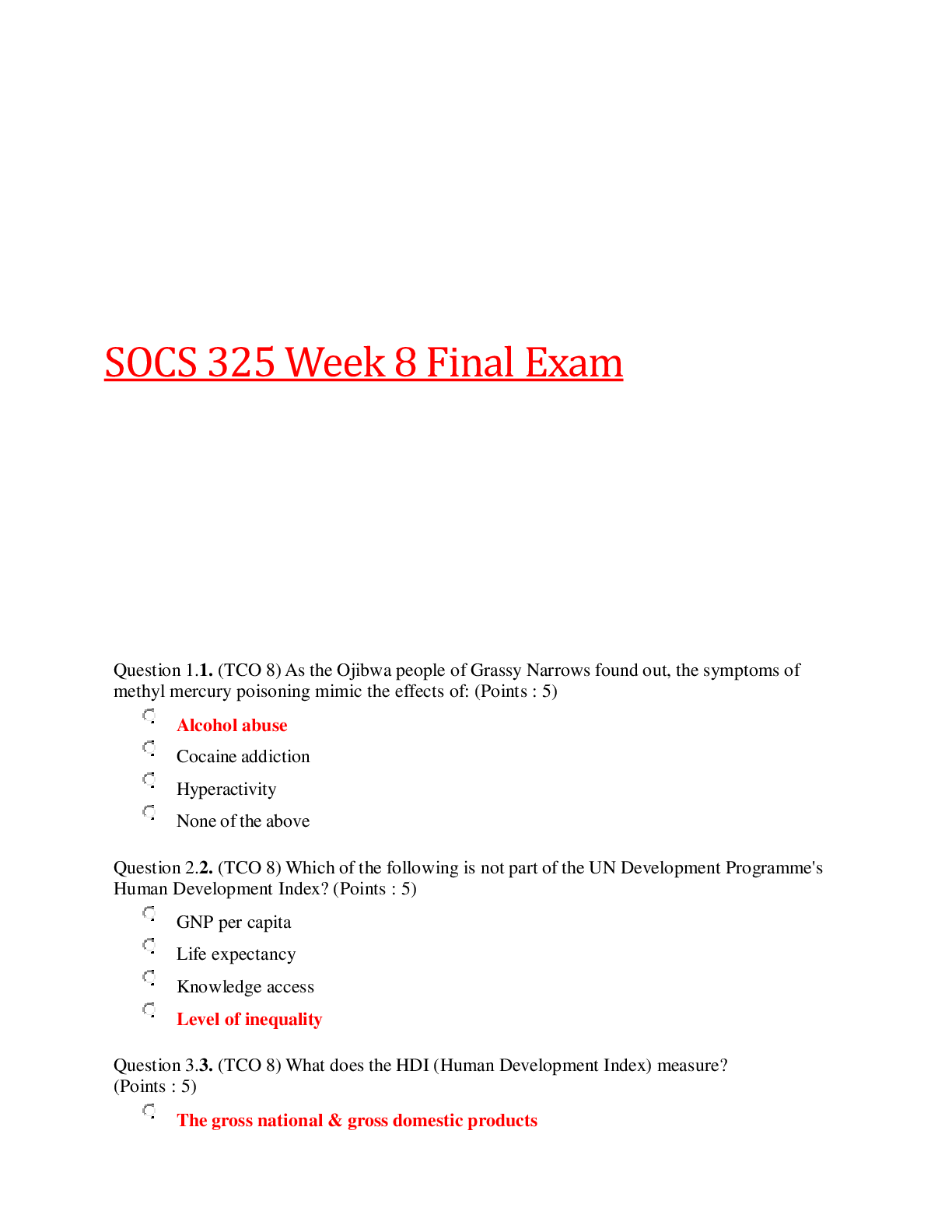
Buy this document to get the full access instantly
Instant Download Access after purchase
Add to cartInstant download
Reviews( 0 )
Document information
Connected school, study & course
About the document
Uploaded On
Nov 07, 2023
Number of pages
11
Written in
Additional information
This document has been written for:
Uploaded
Nov 07, 2023
Downloads
0
Views
47



